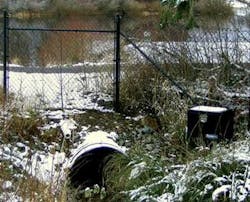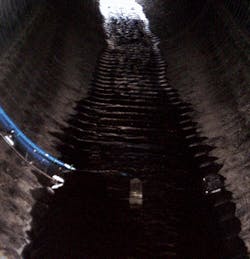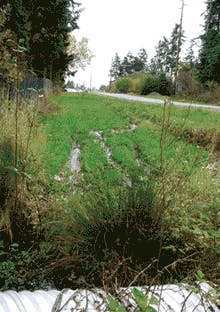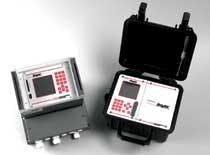by Patrick Stevens
A natural stormwater runoff path that crossed over a prestigious golf course was a concern to residents and the owners of the golf course as the area developed and changes to the landscape drew attention. Residents and stakeholders got together and worked with the City of Oak Harbor, WA, to construct an agreement whereby the City would monitor the stormwater flow from the basin onto the golf course.
The basin is located adjacent to a pond and is situated in a shallow valley. All of the basin's stormwater enters the golf course through a single culvert at the head of the golf course pond. During dry weather, the flow profile is shallow and moves along the corrugated surface. During wet weather, the flow is deeper and more turbulent as it moves across the large stones on the outside of the culvert and along the corrugated pipe discharging into the pond. During significant wet weather events (or close to the end of the wet season), the pond level becomes elevated and a backwater condition becomes present in the pipe, which distorts the flow profile and results in low flow velocities.
“The main challenge is that we don't have control over the level of the pond,” stated Arnold Peterschmidt, project engineer for the City of Oak Harbor. “The highly variable flow and backwater conditions prevent accurate data collection by simple methods that we have used in other locations.”
The corrugated pipe presented unique challenges of its own for sensor installation and also made the low flow periods even more challenging to measure.
This particular location required the recommendation of a flow-metering device that would provide long-term accuracy and durability to the City. Traditional area-velocity (AV) meters installed in this hydraulic environment would experience difficulty measuring the clear, low, and slow velocities developed during the backwater condition, resulting in a lack of quality data capture. It was also an important requirement of this flow-monitoring solution that the City be able to manage the operation and collection of the flow meter on its own without having to pay for data posting or flow-monitoring services. They wanted to manage any operational requirements within the City's current personnel allocation.
In October 2008 the City contracted with ADS Environmental Services to purchase and install a Portable FlowShark Pulse with cross-correlation technology at this location.
Choosing the Appropriate Monitoring Technology
Two primary factors that affect a successful flow-monitoring application include selection of a metering location that offers suitable hydraulic conditions and selection of the proper metering equipment. There are a wide range of Doppler-based technologies that can be used in various open channel site conditions and velocity ranges. They have therefore dominated the marketplace since their initial inception in the wastewater field in the late 1970s.
Recently, other velocity technologies have come into use for measuring open channel flows, including electromagnetic, transit-time, and radar technologies.
Electromagnetic technology relies on the Faraday Principle, which measures velocity of water near a sensor's localized magnetic field and its use in open channel environments is limited to small pipes.
Multiple chordal-path transit-time technology employs internationally recognized integration techniques to provide average section flow velocity. By measuring the time of travel difference of ultrasonic signals of defined chordal paths alternately in the up and downstream directions across the cross-sectional flow area, the average section flow velocity is calculated. Transit-time technology enjoys very comprehensive use in the water, wastewater and hydro- and thermal-power industries.
Radar technology measures surface velocity and assumes a standard relationship between surface and subsurface velocity in the channel.
All open channel flow-monitoring equipment available today is of the AV type and relies on the Continuity Equation, which calculates a flow rate by measuring depth and velocity:
Reliable velocity measurement requires well-established flow which is uniformly parallel to the pipe itself. Conditions that interfere with uniform flow include low velocities (typically <1.0 ft/s), near-full pipes (often due to backwater), highly variable flow rates (often due to pump stations), uneven waves and turbulence, hydraulic jumps and variable silt accumulations. These non-ideal conditions can result in potential errors of more than ±25%.
Cross-correlation technology was introduced in Europe in 2000 and North America in 2006 and relies on gated (or pulsed) energy for determining flow velocity. This technology is more successful in non-ideal conditions: low velocities, near-full pipes, and highly variable flow rates. ADS Environmental Services introduced this technology in North America as the FlowShark® Pulse meter.
Cross-Correlation Meters
Cross-correlation technology relies on pulses of energy and listening gates to calculate velocity as several depths of flow. Pulsed cross-correlation velocity technology removes the need for the Doppler principle and instead relies on the “time shift” of the reflection signature of the particles in the flow. The faster the flow, the greater the time shift. This is a more mathematically reliable calculation than Doppler technology, but it was not practical in flow meters until the recent advancements in digital signal processing (DSP) power in microchips.
Instead of looking for frequency shifts from the moving particles in each gate or depth layer (measurement window), the meter sensor actually stores a response “signature” of particles in each gate during each pulse. The sensor matches, or “cross-correlates,” the particles' signatures from the successive pulses to determine how far the particles travel between pulses. The sensor can conduct several of these correlations and provide a complete vertical profile of flow in up to 16 separate depth layers every second. All of this processing power is contained within a sensor that is the size of a large cigar.
This sensor automatically adjusts gate or measuring window sizes as depths increase. Depths are measured by one of the three available depth-sensing methods: water ultrasonic (uplooker), pressure, or air ultrasonic (downlooker). For this application the uplooking depth and velocity sensor was selected. Velocities are generated for depths ranging from only 1.5 inches up to depths in excess of 12 feet. Highly stable and accurate velocity readings are achievable from less than 0.1 ft/s to over 15 ft/s.
Other features of the meter using this technology sensor include simple installation, integrated programming of the meter transmitter/logger, remote access, SCADA I/O, programmable logic (e.g., to control valves or actuate samplers), and a choice of panel-mounted or temporary (briefcase type) meter/logger interface.
In the United States, this technology is available from ADS in two meter configurations: a portable battery-operated unit and a permanently AC-powered unit. The portable meter met the requirements of the Oak Harbor backflow application due to its durability and low maintenance, flow measurement technology, and easy retrieval of data. There is no software required and all measurements can be obtained from a compact flash card in the meter.
“It was an ideal solution to our stormwater challenge,” said Peterschmidt. “We needed an instrument that would continue to accurately monitor the stormwater in the culvert even in backwater.”
Other stormwater applications for cross-correlation technology include sites that experience a range of velocity flows, even those less than 1ft/s, including creek and drainage locations. The FlowShark Pulse and Portable FlowShark Pulse have also been used successfully in the influent line for wastewater treatment plants, where there are often poorly developed flow profiles, and irrigation channels, where low-flow velocities strain the limits of AV meters to capture reliable data.
About the Author:
Patrick Stevens, P.E., is Vice President of Engineering with ADS Environmental Services.









